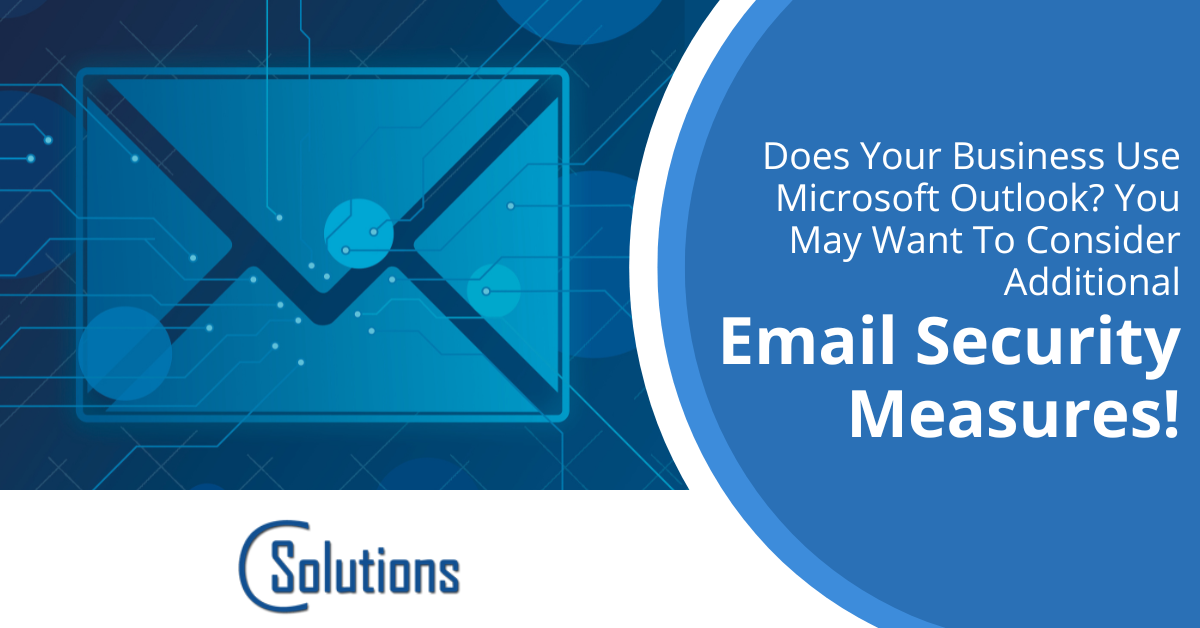Does Your Business Use Microsoft Outlook? You May Want To Consider Additional Email Security Measures!

It’s no secret that email is a critical communication tool for businesses, enabling employees to communicate with colleagues, partners and customers alike. However, given the prominence of email, it’s no surprise that it is also a common target for cyber threats like phishing attacks, spam, and malware. In fact, research shows that employees receive an average of 14 malicious emails per year – and this is a conservative estimate.
Most organizations know that to protect their employees from email-based attacks, they need to implement robust email security measures. However, many companies make the mistake of thinking that native email security controls in the likes of G-Mail and Microsoft Outlook are enough. This isn’t the case.
While these platforms do offer some built-in security features, such as spam filtering and the ability to block certain types of attachments, these capabilities aren’t enough to protect against the complex myriad of email-borne threats out there, as we’ll explore below.
What Are The Most Prevalent Forms Of Email Cyber-Attack?
Before we explore the weaknesses of in-built email security tools, it’s first crucial to understand why investing in email security is so important. Email cyber-attacks can have serious consequences for organizations, including data loss, disruption of business operations, and damage to reputation. Here are some of the most common attack tactics:
- Phishing attacks: Phishing attacks are designed to trick users into divulging sensitive information, such as login credentials or financial information. These attacks are often disguised as legitimate emails, and may include links to fake websites or attachments that contain malware.
- Spam: Spam emails are unsolicited emails that are often sent in large volumes. While most spam emails are harmless, they can be used to deliver malicious content such as phishing attacks or malware.
- Malware: Malware is short for “malicious software,” and refers to any software that is designed to harm or exploit a computer system. Malware can be delivered via email as an attachment or a link, and can have a range of consequences, including data loss, system disruption, and unauthorized access to systems.
- Ransomware: Ransomware is a type of malware that encrypts a victim’s files and demands a ransom from the victim to restore access. Ransomware can be delivered via email as an attachment or a link, and can have serious consequences for organizations, including data loss and disruption of business operations.
- Business email compromise (BEC): Business email compromise (BEC) attacks are designed to trick employees into transferring funds or divulging sensitive information. These attacks often involve the attacker impersonating a senior executive or a trusted vendor, and may include requests for wire transfers or the release of confidential information.
What Are The Weaknesses Of Native Email Security Tools?
Given that there are so many attacks targeting email-based communications, it’s crucial to ensure your business is properly protected. And yet, platforms like Google Workplace and Microsoft Outlook rarely fulfill a company’s security needs. Here’s why:
- Built-in spam filters are not always effective. While these platforms include spam filters, they are not always able to accurately identify and block spam emails. This can lead to spam emails slipping through the filter and being delivered to users’ inboxes, which can put the organization at risk of falling victim to a phishing attack or other type of cyber threat.
- Hit and miss protection against advanced threats: Built-in security features are able to identify and block certain types of malicious attachments, but they won’t protect against more advanced threats such as zero-day exploits or ransomware. These types of threats can have serious consequences for organizations, including data loss and disruption of business operations.
- Outlook does not offer encryption for email attachments. Email attachments can contain sensitive or confidential information that needs to be protected. While Outlook does offer the ability to password-protect attachments, it does not offer encryption, which is a more secure method of protecting data.
How Can I Enhance My Company’s Email Security Posture?
To address email security concerns, organizations need to implement additional email security tools when they use tools like Google Workspace or Outlook. There are a wide range of email security solutions available that we recommend, including:
- Advanced spam filters: These tools are designed to provide more accurate and effective spam filtering than what is offered by Outlook. They use advanced algorithms and machine learning techniques to identify and block spam emails before they reach users’ inboxes.
- Email encryption: Email encryption tools enable organizations to secure the contents of their email messages and attachments. This can help to protect sensitive or confidential information from being accessed by unauthorized parties.
- Advanced threat protection: These tools are designed to detect and prevent advanced cyber threats such as zero-day exploits and ransomware. They use a combination of techniques, such as sandboxing and behavioral analysis, to identify and block these types of threats.
While, on first look, you may be concerned about investing in a plethora of complex tools to protect your employees’ inboxes, you needn’t worry. Many leading security providers deliver end-to-end email security solutions with all of these features and more.
One such provider, which we are proud to partner with, is Trend Micro. Its email security solution offers a range of best-in-class features including spam filtering, email encryption, and advanced threat protection. It uses machine learning algorithms to identify and block spam emails and other types of threats, and also offers a secure email gateway that can filter out malicious emails before they reach users’ inboxes.
If you’d like to learn more about our email security solutions, contact us today for a free, no-obligation consultation.
